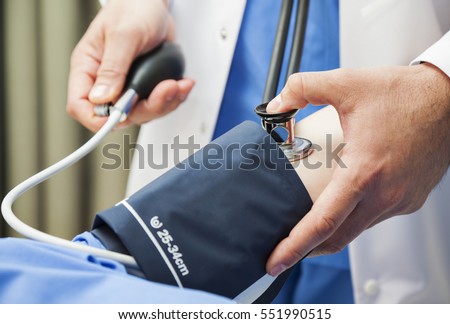High blood pressure (hypertension) is defined as high pressure (tension) in the arteries, which are the vessels that carry blood from the heart to the rest of the body.
Blood pressure readings are given as two numbers:The systolic blood pressure (the top number) equals the pressure in the arteries as the heart contracts.
The diastolic pressure (the bottom number) is the pressure in the arteries as the heart relaxes.Normal blood pressure is below 120/80.In 2017, the American College of Cardiology released new guidelines for high blood pressure.Blood pressure between 120/80 and 129/80 is elevated blood pressure, and a blood pressure of 130/80 or above is considered high.

The American Academy of Cardiology defines blood pressure ranges as:
Hypertension stage 1 is 130-139 or 80-89 mm Hg, and hypertension stage 2 is 140 or higher, or 90 mm Hg or higher.Complications of high blood pressure include heart disease, kidney (renal) disease, hardening of the arteries (atherosclerosis or arteriosclerosis), eye damage, and stroke (brain damage).Hypertension is a major public health problem. With the new guidelines for defining high blood pressure, The American Heart Association estimates high blood pressure affects nearly half of all adults (46%) in the United States.




Blood pressure readings are given as two numbers:The systolic blood pressure (the top number) equals the pressure in the arteries as the heart contracts.
The diastolic pressure (the bottom number) is the pressure in the arteries as the heart relaxes.Normal blood pressure is below 120/80.In 2017, the American College of Cardiology released new guidelines for high blood pressure.Blood pressure between 120/80 and 129/80 is elevated blood pressure, and a blood pressure of 130/80 or above is considered high.

Hypertension stage 1 is 130-139 or 80-89 mm Hg, and hypertension stage 2 is 140 or higher, or 90 mm Hg or higher.Complications of high blood pressure include heart disease, kidney (renal) disease, hardening of the arteries (atherosclerosis or arteriosclerosis), eye damage, and stroke (brain damage).Hypertension is a major public health problem. With the new guidelines for defining high blood pressure, The American Heart Association estimates high blood pressure affects nearly half of all adults (46%) in the United States.
SYMPTOMS OF HIGH BLOOD PRESSURE
- Chest pain
- Shortness of breath
- Weakness
- Nausea and vomiting
People often do not seek medical care until they have symptoms arising from the organ damage caused by chronic (ongoing, long-term) high blood pressure. These types of organ damage are commonly seen in chronic high blood pressure.
- Heart attack
- Heart failure
- Stroke or transient ischemic attack(TIA, mini-stroke) caused by narrowed blood vessels or because of an aneurysm
- Kidney failure
- Eye damage with progressive vision loss
- Peripheral arterial disease causing leg pain with walking (claudication)
- Outpouchings of the aorta, called aneurysms
About 1% of people with high blood pressure do not seek medical care until the high blood pressure is very severe, a condition known as malignant hypertension or a hypertensive emergency.
- In malignant hypertension, the diastolic blood pressure (the lower number) often exceeds 120 mm Hg.
- Malignant hypertension may be associated with headache, lightheadedness, nausea, vomiting, and stroke like symptoms
- Malignant hypertension requires emergency intervention and lowering of blood pressure to prevent brain hemorrhage or stroke.
It is of utmost importance to realize that high blood pressure can be unrecognized for years, causing no symptoms but causing progressive damage to the heart, other organs, and blood vessels.
CAUSES OF HIGH BLOOD PRESSURE
There are several factors that may cause high blood pressure, but the exact cause is unknown. The following factors may increase one's risk for high blood pressure:

- Smoking
- Overweight or obesity
- Lack of physical activity
- Too much salt consumption
- Too much alcohol consumption (more than 1 to 2 drinks per day)
- Stress
- Older age
- Genetics
- Family history of high blood pressure
- Chronic kidney disease
- Adrenal and thyroid disorders
- Sleep apnea
HOW TO CURE HIGH BLOOD PRESSURE NATURALLY
Lifestyle plays an important role in treating your high blood pressure. If you successfully control your blood pressure with a healthy lifestyle, you might avoid, delay or reduce the need for medication.
Here are 5 lifestyle changes you can make to lower your blood pressure and keep it down.
1. Lose extra pounds and watch your waistline
Blood pressure often increases as weight increases. Being overweight also can cause disrupted breathing while you sleep (sleep apnea), which further raises your blood pressure.
Weight loss is one of the most effective lifestyle changes for controlling blood pressure. Losing just 10 pounds (4.5 kilograms) can help reduce your blood pressure.
Besides shedding pounds, you generally should also keep an eye on your waistline. Carrying too much weight around your waist can put you at greater risk of high blood pressure.
In general:
- Men are at risk if their waist measurement is greater than 40 inches (102 centimeters).
- Women are at risk if their waist measurement is greater than 35 inches (89 centimeters).
These numbers vary among ethnic groups. Ask your doctor about a healthy waist measurement for you.
2. Exercise regularly
Regular physical activity — at least 30 minutes most days of the week — can lower your blood pressure by 4 to 9 millimeters of mercury (mm Hg). It's important to be consistent because if you stop exercising, your blood pressure can rise again.

If you have slightly high blood pressure (prehypertension), exercise can help you avoid developing full-blown hypertension. If you already have hypertension, regular physical activity can bring your blood pressure down to safer levels.
The best types of exercise for lowering blood pressure include walking, jogging, cycling, swimming or dancing. Strength training also can help reduce blood pressure. Talk to your doctor about developing an exercise program.
3. Eat a healthy diet
Eating a diet that is rich in whole grains, fruits, vegetables and low-fat dairy products and skimps on saturated fat and cholesterol can lower your blood pressure by up to 14 mm Hg. This eating plan is known as the Dietary Approaches to Stop Hypertension (DASH) diet.

It isn't easy to change your eating habits, but with these tips, you can adopt a healthy diet:
- Keep a food diary. Writing down what you eat, even for just a week, can shed surprising light on your true eating habits. Monitor what you eat, how much, when and why.
- Consider boosting potassium. Potassium can lessen the effects of sodium on blood pressure. The best source of potassium is food, such as fruits and vegetables, rather than supplements. Talk to your doctor about the potassium level that's best for you.
- Be a smart shopper. Read food labels when you shop and stick to your healthy-eating plan when you're dining out, too.
4. Reduce sodium in your diet
Even a small reduction in the sodium in your diet can reduce blood pressure by 2 to 8 mm Hg.
The effect of sodium intake on blood pressure varies among groups of people. In general, limit sodium to less than 2,300 milligrams (mg) a day or less. However, a lower sodium intake — 1,500 mg a day or less — is appropriate for people with greater salt sensitivity, including:
- African-Americans
- Anyone age 51 or older
- Anyone diagnosed with high blood pressure, diabetes or chronic kidney disease
To decrease sodium in your diet, consider these tips:
- Read food labels. If possible, choose low-sodium alternatives of the foods and beverages you normally buy.
- Eat fewer processed foods. Only a small amount of sodium occurs naturally in foods. Most sodium is added during processing.
- Don't add salt. Just 1 level teaspoon of salt has 2,300 mg of sodium. Use herbs or spices to add flavor to your food.
- Ease into it. If you don't feel you can drastically reduce the sodium in your diet suddenly, cut back gradually. Your palate will adjust over time.
5. Say"No" To Alcohol
Alcohol can be both good and bad for your health. In small amounts, it can potentially lower your blood pressure by 2 to 4 mm Hg.

But that protective effect is lost if you drink too much alcohol — generally more than one drink a day for women and for men older than age 65, or more than two a day for men age 65 and younger. One drink equals 12 ounces of beer, five ounces of wine or 1.5 ounces of 80-proof liquor.
Drinking more than moderate amounts of alcohol can actually raise blood pressure by several points. It can also reduce the effectiveness of blood pressure medications.
THANK YOU!!!